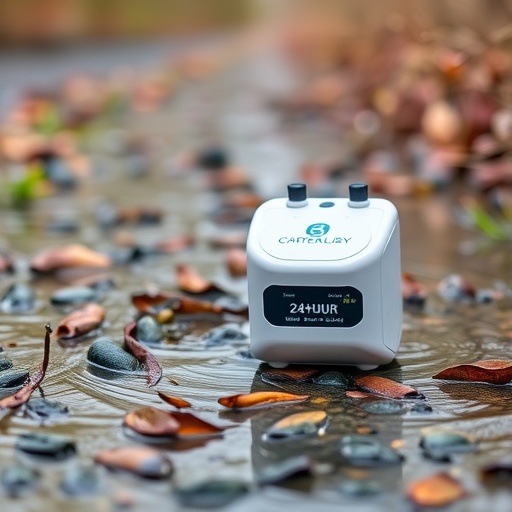In an era where urban pollution presents significant challenges to environmental health, the quest for effective monitoring systems of water quality has become increasingly crucial. A recent study led by researchers including McKenzie, Pllu, and Campbell has unveiled a groundbreaking 24-hour water sampler designed specifically to monitor particulate and dissolved pollutants from roadways. This innovative device is set to revolutionize how we track water contaminants that stem from vehicular activity and urban runoff, which have long posed threats to both aquatic ecosystems and public health.
The urgency of tracking road pollutants cannot be overstated. Every day, vehicles discharge a myriad of substances into the environment, ranging from heavy metals to organic compounds. These pollutants enter water systems through varied pathways, especially during rain events when stormwater runoff can carry contaminants into nearby rivers, lakes, and oceans. This study meticulously delves into the design and effectiveness of a sampler that operates continuously over a 24-hour cycle, ensuring a comprehensive collection of temporal data that can elucidate fluctuations in pollutant loads.
This novel water sampler is engineered to collect both dissolved and particulate pollutants, aiming to mirror real-world conditions more accurately than previous models. Traditional sampling methods often rely on discrete sample collection, which can provide only a snapshot of water quality. However, with the new 24-hour system, researchers can gather a more holistic view of contaminants over time, capturing variations caused by factors such as traffic patterns, weather changes, and peak hours of pollutant discharge.
The design features of this advanced sampler showcase a blend of durability and precision. It integrates sensors that are capable of monitoring water flow and automatically collecting samples in proportion to varying flow rates. This proportional sampling is advantageous because it allows for accurate representation of pollutant concentrations during different hydrological events. The engineers placed particular emphasis on user-friendliness and resilience in urban environments, ensuring that the equipment can withstand harsh weather conditions and tampering.
Testing of the sampler has already begun, with initial studies conducted in urban settings where traffic emissions are a significant concern. The preliminary results have shown that this technology can effectively capture a wide range of pollutants, enabling researchers to identify and quantify specific contaminants attributed to vehicular traffic and urban runoff. This data is invaluable for urban planners and environmental managers who need to develop strategies to mitigate pollution impacts on local water bodies.
In the context of increasing regulations on water quality, the need for reliable monitoring tools is more pertinent than ever. Governments around the world are grappling with the necessity to meet stricter water quality standards, and advanced monitoring technology like this sampler can assist in compliance efforts. It equips municipalities with the critical data needed to make informed decisions regarding urban development and infrastructure improvement.
Furthermore, the implications of this research reach beyond mere data collection. Understanding the nuances of water pollution from roadways can directly influence public health initiatives. Contaminants absorbed by aquatic ecosystems can bioaccumulate, posing risks to fish and other wildlife that humans may consume. By providing detailed insights into pollutant concentrations, the new sampler can aid in assessing risks to both ecological and human health.
Public awareness of environmental issues escalates the demand for transparency in how pollutants are monitored and managed. Stakeholders, including community groups and environmental organizations, will find value in the utilization of such advanced technology. Presenting accessible data on water quality can empower residents to advocate for cleaner environments and more sustainable urban policies.
Equipped with the results gleaned from this sampler, researchers can also explore potential correlations between pollution levels and various health outcomes in local populations. This intersection of environmental and human health research could lead to novel interventions aimed at protecting vulnerable communities living near heavily trafficked areas.
As this study unfolds further, the scientific community anticipates the emergence of new methodologies that can be built upon the foundation laid by the 24-hour water sampler. The principles of data collection and environmental monitoring can be extrapolated to other domains, such as industrial pollution and agricultural runoff, broadening the sampler’s application and impact in broader environmental science.
In the pursuit of sustainability, the research aligns perfectly with ongoing efforts to innovate and advocate for cleaner technologies and practices. This technology lays crucial groundwork for a future where proactive measures against water pollution are not just reactive responses but part of a cohesive strategy towards sustainable urban living.
Beyond individual research contributions, collaborative efforts among scientists, policymakers, and the public can enhance the efficacy of such water monitoring tools. Engaging diverse perspectives ensures that the policy implications of pollutant monitoring align with community needs and desires. As this dialogue continues, the potential for holistic environmental stewardship grows exponentially.
In summary, the unveiling of the new 24-hour water sampler by McKenzie and colleagues marks a significant milestone in environmental monitoring technology. Its advanced capabilities not only stand to improve data accuracy concerning urban water pollutants but also promise to play a pivotal role in shaping future environmental policies and health outcomes. As cities continue to grow and face unprecedented challenges from pollution, tools like this will be essential for safeguarding the health of both our ecosystems and ourselves.
One cannot help but feel a sense of optimism as we look towards a future enriched by enhanced environmental accountability and innovative solutions. The commitment to understanding and addressing the realities of water pollution heralds a new chapter in our ongoing struggle for a cleaner and safer planet.
Subject of Research: Monitoring particulate and dissolved road pollutants using a new water sampler
Article Title: Design and application of a new 24-h water sampler for monitoring particulate and dissolved road pollutants
Article References:
McKenzie, K., Pllu, A., Campbell, I. et al. Design and application of a new 24-h water sampler for monitoring particulate and dissolved road pollutants.
Environ Monit Assess 197, 1191 (2025). https://doi.org/10.1007/s10661-025-14671-6
Image Credits: AI Generated
DOI:
Keywords: Water quality, pollution monitoring, 24-hour sampler, road pollutants, environmental health




